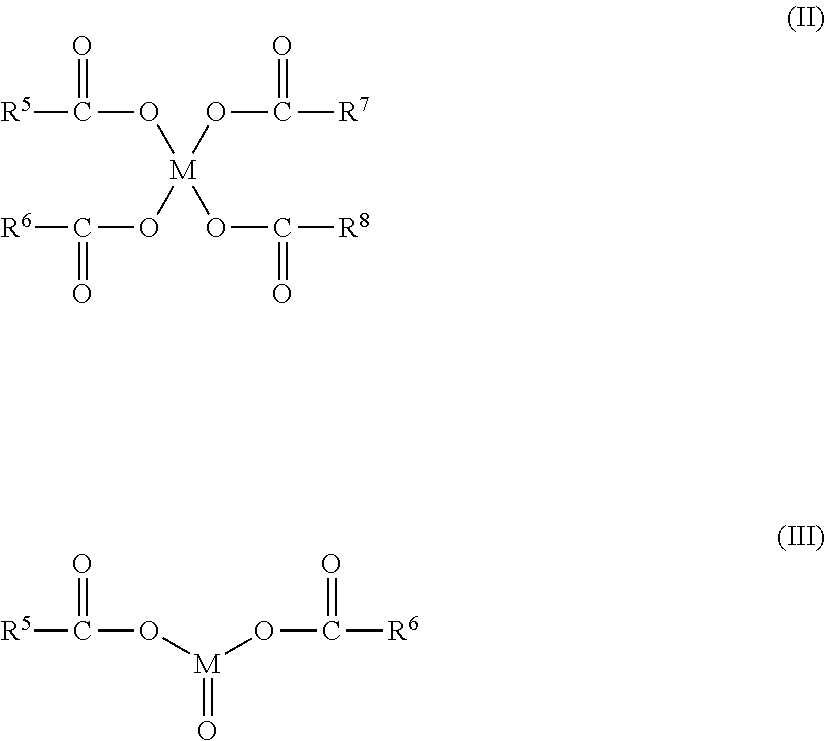Iminooxadiazinedione polyisocyanates
- Summary
- Abstract
- Description
- Claims
- Application Information
AI Technical Summary
Benefits of technology
Problems solved by technology
Method used
Image
Examples
example 1
Inventive
[0081]840 g (5 mol) of hexamethylene diisocyanate (HDI) were initially charged at a temperature of 115° C. under dry nitrogen with stirring and admixed four times with 0.04 g each time of zirconium tetra-n-butylate as catalyst, at intervals of about 40 min in each case. A rapidly decreasing exotherm which caused the reaction mixture to heat up to 118-119° C. for a short time was observable immediately after each catalyst addition. Following addition of the final amount of catalyst, the mixture was stirred at 115° C. for a further two hours until an NCO content of 42.5% had been achieved. The catalyst was then deactivated by adding 0.5 g of a 10% strength solution of isophthaloyl dichloride in HDI and subsequently stirring for 15 minutes. Finally, the unconverted monomeric HDI was separated off in a thin layer evaporator at a temperature of 130° C. and a pressure of 0.1 mbar.
[0082]A practically colourless, clear polyisocyanate mixture was obtained, which had the following ch...
example 2
Inventive
[0083]In accordance with the process described in Example 1, 840 g (5 mol) of HDI were reacted by portionwise addition of a total of 0.2 g of zirconium tetra-2-ethylhexylate. The reaction was terminated as described in Example 1, at an NCO content of 43.8%, with 1.4 g of a 10% strength solution of isophthaloyl dichloride in HDI and the reaction mixture was worked up by distillation. A practically colourless, clear polyisocyanate mixture was obtained, which had the following characteristics and composition:
NCO content: 23.1%
monomeric HDI: 0.22%
viscosity (23° C.): 840 mPas
iminooxadiazinedione groups: 37.5 mol %
isocyanurate groups: 60.4 mol %
uretdione groups: 2.1 mol %
iminooxadiazinedione / isocyanurate: 38.3:61.7
example 3
Inventive
[0084]In accordance with the process described in Example 1, 840 g (5 mol) of HDI were reacted by portionwise addition of a total of 0.8 g of a 10% strength solution of zirconium tetraethylate in chlorobenzene. The reaction was terminated as described in Example 1, at an NCO content of 41.8%, with 0.6 g of a 10% strength solution of isophthaloyl dichloride in HDI and the reaction mixture was worked up by distillation.
[0085]A practically colourless, clear polyisocyanate mixture was obtained, which had the following characteristics and composition:
NCO content: 22.2%
monomeric HDI: 0.15%
viscosity (23° C.): 1950 mPas
iminooxadiazinedione groups: 20.4 mol %
isocyanurate groups: 75.4 mol %
uretdione groups: 4.2 mol %
iminooxadiazinedione / isocyanurate: 21.3:78.7
PUM
| Property | Measurement | Unit |
|---|---|---|
| Temperature | aaaaa | aaaaa |
| Temperature | aaaaa | aaaaa |
| Fraction | aaaaa | aaaaa |
Abstract
Description
Claims
Application Information
 Login to View More
Login to View More - R&D
- Intellectual Property
- Life Sciences
- Materials
- Tech Scout
- Unparalleled Data Quality
- Higher Quality Content
- 60% Fewer Hallucinations
Browse by: Latest US Patents, China's latest patents, Technical Efficacy Thesaurus, Application Domain, Technology Topic, Popular Technical Reports.
© 2025 PatSnap. All rights reserved.Legal|Privacy policy|Modern Slavery Act Transparency Statement|Sitemap|About US| Contact US: help@patsnap.com



